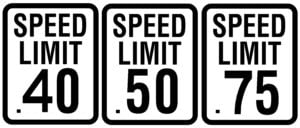The 2008 discovery of the Shoreline fault closely offshore from the Diablo Canyon nuclear plant again raised the question of whether its reactors conform to the NRC’s safety regulations governing seismic protection.
Depending on which NRC document you read, the “speed limit” at Diablo Canyon against ground acceleration caused by earthquake is 0.4g, 0.5g, or 0.75g. It’s tough to enforce a speed limit when you only know that it’s somewhere between stopped and the speed of light.
PG&E sought to answer this question by requesting that the NRC formally revise the safe shutdown earthquake (SSE) level to the level the company had evaluated for the Hosgri fault under its Long Term Seismic Program (LTSP) in the 1980s. PG&E believes the plant can withstand the ground motion caused by an earthquake on the Shoreline fault. But it has never performed a rigorous analysis of the Hosgri and Shoreline faults using the methods and assumptions required to legally re-define the seismic design basis. As a result, the NRC does not have the information it needs to determine that Diablo Canyon can operate safely.
Dr. Michael Peck, then an NRC resident inspector at Diablo Canyon, pointed out numerous deficiencies in PG&E’s evaluation of the Shoreline fault. Peck concluded that more analysis and likely additional modifications would be necessary before anyone could honestly claim that Diablo Canyon was adequately protected from an earthquake originating along the Shoreline fault.
Even if the Diablo Canyon reactors can in fact withstand the level of earthquakes PG&E asserts they can (0.75g), NRC analysis shows that there is roughly a 1-in-6 chance that the reactors will experience an earthquake larger than that over their 40-year lifetime. This suggests that even if the reactors are capable of withstanding 0.75g of ground motion, that may still be inadequate to ensure public safety.
Despite this, the NRC allows the Diablo Canyon reactors to continue operating.
At many other plants, the NRC put safety ahead of other considerations by not allowing nuclear facilities to operate if they had unanswered seismic safety questions. Yet the NRC allows Diablo Canyon to operate based on unsubstantiated beliefs that the plant can withstand the threat from the Hosgri and Shoreline faults.
At these other plants, the NRC did not rely on luck to protect the public. Instead, it relied on compliance with federal safety regulations to provide that protection. The NRC is betting that the big one won’t make Diablo Canyon the next nuclear nightmare. When the stakes involve tens of thousands of Californians, the NRC should stop wagering and resume regulating.
As it has at other plants with similar issues, the NRC should enforce its seismic regulations at Diablo Canyon.
The Alliance for Nuclear Responsibility in California asked UCS to look at how the NRC handled seismic issues at other facilities and to determine if the agency is currently treating seismic issues at Diablo Canyon. Our research is documented in Seismic Shift: Diablo Canyon Literally and Figuratively on Shaky Ground. Our report details the foundation for and path to the conclusions above.


